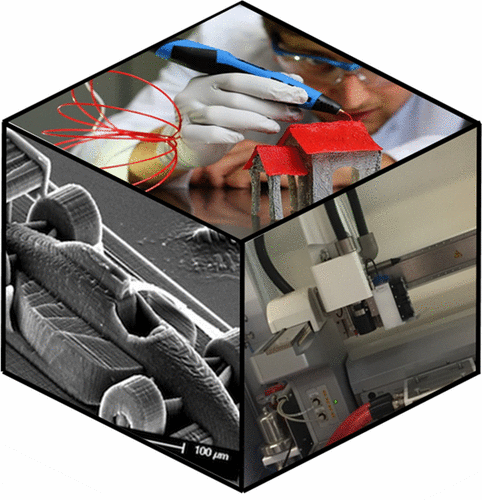当前位置:
X-MOL 学术
›
Chem. Rev.
›
论文详情
Our official English website, www.x-mol.net, welcomes your
feedback! (Note: you will need to create a separate account there.)
Polymers for 3D Printing and Customized Additive Manufacturing
Chemical Reviews ( IF 51.4 ) Pub Date : 2017-07-30 00:00:00 , DOI: 10.1021/acs.chemrev.7b00074 Samuel Clark Ligon 1 , Robert Liska , Jürgen Stampfl , Matthias Gurr 2 , Rolf Mülhaupt 3
Chemical Reviews ( IF 51.4 ) Pub Date : 2017-07-30 00:00:00 , DOI: 10.1021/acs.chemrev.7b00074 Samuel Clark Ligon 1 , Robert Liska , Jürgen Stampfl , Matthias Gurr 2 , Rolf Mülhaupt 3
Affiliation

|
Additive manufacturing (AM) alias 3D printing translates computer-aided design (CAD) virtual 3D models into physical objects. By digital slicing of CAD, 3D scan, or tomography data, AM builds objects layer by layer without the need for molds or machining. AM enables decentralized fabrication of customized objects on demand by exploiting digital information storage and retrieval via the Internet. The ongoing transition from rapid prototyping to rapid manufacturing prompts new challenges for mechanical engineers and materials scientists alike. Because polymers are by far the most utilized class of materials for AM, this Review focuses on polymer processing and the development of polymers and advanced polymer systems specifically for AM. AM techniques covered include vat photopolymerization (stereolithography), powder bed fusion (SLS), material and binder jetting (inkjet and aerosol 3D printing), sheet lamination (LOM), extrusion (FDM, 3D dispensing, 3D fiber deposition, and 3D plotting), and 3D bioprinting. The range of polymers used in AM encompasses thermoplastics, thermosets, elastomers, hydrogels, functional polymers, polymer blends, composites, and biological systems. Aspects of polymer design, additives, and processing parameters as they relate to enhancing build speed and improving accuracy, functionality, surface finish, stability, mechanical properties, and porosity are addressed. Selected applications demonstrate how polymer-based AM is being exploited in lightweight engineering, architecture, food processing, optics, energy technology, dentistry, drug delivery, and personalized medicine. Unparalleled by metals and ceramics, polymer-based AM plays a key role in the emerging AM of advanced multifunctional and multimaterial systems including living biological systems as well as life-like synthetic systems.
中文翻译:

用于 3D 打印和定制增材制造的聚合物
增材制造 (AM) 别名 3D 打印将计算机辅助设计 (CAD) 虚拟 3D 模型转化为物理对象。通过 CAD、3D 扫描或断层扫描数据的数字切片,AM 可以逐层构建对象,无需模具或机加工。通过利用数字信息存储和互联网检索,增材制造能够按需分散制造定制对象。从快速原型制造到快速制造的持续转变给机械工程师和材料科学家等带来了新的挑战。由于聚合物是迄今为止最常用的增材制造材料,因此本综述重点关注聚合物加工以及专门用于增材制造的聚合物和先进聚合物系统的开发。涵盖的增材制造技术包括还原光聚合(立体光刻)、粉末床熔融 (SLS)、材料和粘合剂喷射(喷墨和气溶胶 3D 打印)、片材层压 (LOM)、挤出(FDM、3D 点胶、3D 纤维沉积和 3D 绘图)和 3D 生物打印。增材制造中使用的聚合物范围包括热塑性塑料、热固性塑料、弹性体、水凝胶、功能性聚合物、聚合物共混物、复合材料和生物系统。讨论了与提高构建速度和提高精度、功能、表面光洁度、稳定性、机械性能和孔隙率相关的聚合物设计、添加剂和加工参数等方面。选定的应用展示了基于聚合物的增材制造如何在轻量化工程、建筑、食品加工、光学、能源技术、牙科、药物输送和个性化医疗中得到应用。与金属和陶瓷相比,基于聚合物的增材制造在先进多功能和多材料系统(包括活生物系统以及类生命合成系统)的新兴增材制造中发挥着关键作用。
更新日期:2017-07-30
中文翻译:

用于 3D 打印和定制增材制造的聚合物
增材制造 (AM) 别名 3D 打印将计算机辅助设计 (CAD) 虚拟 3D 模型转化为物理对象。通过 CAD、3D 扫描或断层扫描数据的数字切片,AM 可以逐层构建对象,无需模具或机加工。通过利用数字信息存储和互联网检索,增材制造能够按需分散制造定制对象。从快速原型制造到快速制造的持续转变给机械工程师和材料科学家等带来了新的挑战。由于聚合物是迄今为止最常用的增材制造材料,因此本综述重点关注聚合物加工以及专门用于增材制造的聚合物和先进聚合物系统的开发。涵盖的增材制造技术包括还原光聚合(立体光刻)、粉末床熔融 (SLS)、材料和粘合剂喷射(喷墨和气溶胶 3D 打印)、片材层压 (LOM)、挤出(FDM、3D 点胶、3D 纤维沉积和 3D 绘图)和 3D 生物打印。增材制造中使用的聚合物范围包括热塑性塑料、热固性塑料、弹性体、水凝胶、功能性聚合物、聚合物共混物、复合材料和生物系统。讨论了与提高构建速度和提高精度、功能、表面光洁度、稳定性、机械性能和孔隙率相关的聚合物设计、添加剂和加工参数等方面。选定的应用展示了基于聚合物的增材制造如何在轻量化工程、建筑、食品加工、光学、能源技术、牙科、药物输送和个性化医疗中得到应用。与金属和陶瓷相比,基于聚合物的增材制造在先进多功能和多材料系统(包括活生物系统以及类生命合成系统)的新兴增材制造中发挥着关键作用。










































 京公网安备 11010802027423号
京公网安备 11010802027423号